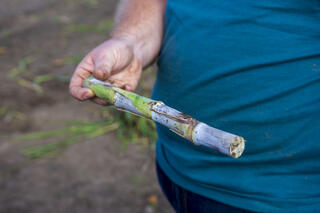
Like each of the four U.S. Department of Energy Bioenergy Research Centers, the Great Lakes Bioenergy Research Center at UW–Madison has a unique scientific focus, but collaboration is key to developing cost-effective plant-based fuels to support a domestic bioeconomy.
Most recently, GLBRC scientists worked with partners at the Center for Advanced Bioenergy and Bioproducts Innovation (CABBI) and the Joint BioEnergy Institute (JBEI) on an investigation into how different pretreatment methods affect production of fuels and chemicals from sugarcane.
In a traditional biorefinery, sugarcane stalks are crushed to extract juice, which microbes ferment into ethanol, and the leftover stalks are burned.
Those stalks, like wood and other plant fibers, also contain sugars and other raw materials, which could provide a renewable source of homegrown fuels and chemicals used to make plastics and other products. But producing such “second generation” biofuels from non-food plants is tricky because it requires separating the sugars (cellulose and hemicellulose) from lignin, a complex polymer that provides rigidity.
Deconstruction techniques often involve a combination of heat, pressure, and harsh chemicals, which can be expensive or introduce compounds that inhibit fermentation, so BRC scientists are working to develop pretreatment methods that are cost-effective and don’t compromise downstream processes.
For a recent CABBI-led study published in the journal Sustainable Energy & Fuels, GLBRC developed a pretreatment method using ammonia dissolved in water, which was used to process samples of oilcane, an oil-rich variety of sugarcane.

CABBI found that the aqueous ammonia pretreatment produced higher sugar and ethanol yields than either of the other methods (hydrothermal and ionic liquid), though hydrothermal pretreatment produced better fatty acid yields.
While GLBRC research focuses on other bioenergy feedstocks — primarily switchgrass, sorghum, and poplar — the feedstock-to-fuels comparison project was part of a set of common goals, referred to as Shared Research Objectives, established in 2023 to leverage each center’s strengths while encouraging collaboration.
Ongoing SROs include head-to-head comparisons of other techniques as well as pooled data and tools for improving crops and the microbes that convert them into fuels and products.
GLBRC co-investigator Trey Sato, whose lab provided samples for the study, said funding and support from each center’s leadership made the inter-BRC collaboration manageable.
“It’s exponentially more difficult — even with scheduling meeting times that work — to collaborate productively with two or three other groups,” Sato said. “This SRO format forced all of us to sit in a Zoom room together to share ideas and come up with plans together.”